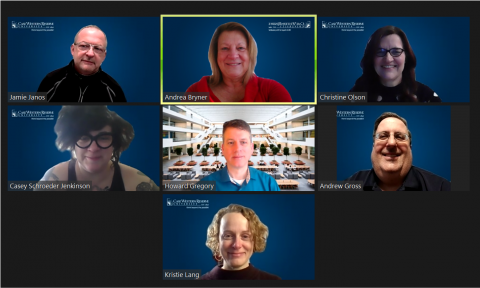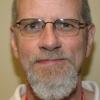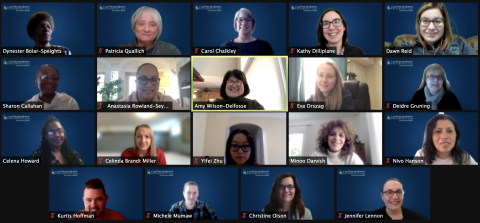It's been one year since COVID-19 began to change our lives forever. In all facets of daily life and by varying degrees, the virus has impacted every one of us. And in our individual ways, we have risen to confront this wicked, relentless challenge.
I want to recognize several of our faculty, staff and partners who have responded to get us to a safer, healthier, more informed and enlightened place. This list is by no means complete. Over 200 faculty members were and are engaged in COVID-19 research and teams of staff and support employees have kept everything running smoothly throughout the pandemic. So many of you have contributed in immeasurable ways, and we cannot possibly include all the deserving and much-appreciated individuals serving in a variety of roles that have made an incredible impact.
My hope is that by acknowledging a few of our colleagues, we shine a light on the spirit of caring and compassion in us all. Please take a moment to read their stories below.
And so, to everyone at the School of Medicine, the Case Comprehensive Cancer Center, our affiliate hospital partners, our colleagues at the university and our comrades in the community who have kept on teaching, discovering, assisting, diagnosing, treating, reaching out and doing what each of us do to get through 2020 and beyond—thank you.
A few of the School of Medicine's COVID-19 Heroes
Anna Bruchez
A researcher and instructor of pathology, Bruchez identified a novel co-factor required for SARS-COVID infection and many other viruses that help to infect cells. She was the lead author for a study that identified a new pathway for protecting cells from these deadly viruses, including the coronavirus and the Ebola virus. The technique takes advantage of a screening mechanism for seeking out new genes that can prevent infection, which could help to fill gaps in scientists’ knowledge about the cellular mechanisms that block viral infections.
Andrea Bryner and Simulation Center Team
Bryner, administrative director of the Mt. Sinai Skills and Simulation Center, and her team empathetically and skillfully managed the uncertainty of COVID-19 for the medical education faculty, staff and students and supported educational programs. All are stewards of our state-of-the-art interprofessional simulation center, educating learners and healthcare providers at many different stages in their professional development.
Matt Burdett
Burdett, assistant director of Facilities Planning, implemented all proper social distancing recommendations to align with the university’s COVID-19 policies as he prepared space for staff and students to be able to return to offices, classrooms and laboratories. He oversaw the expeditious refurbishment of the BRB 10 BSL3 lab to accommodate COVID research. As the university becomes a vaccine administration site, Burdett continues to establish vaccine storage facilities according to all necessary CDC and manufacturer requirements.
Mark Cameron
Within the School of Medicine, Mark Cameron, virologist, immunologist and associate professor for the Department of Quantitative Health Sciences, has become the expert voice for information about the pandemic, consistently providing updated information about the virus with local and national media. Because of his experience with the SARS pandemic in Toronto, Canada in 2003 and his current expertise, he has continued to provide breaking news and expertise throughout COVID-19.
Clinical and Translational Science Collaborative (CTSC)
During the early months of the pandemic, the CTSC along with the COVID-19 Task Force sponsored the Rapid Response COVID-19 Related Pilot Funding Research Opportunity. With support from multiple funding partners across CWRU, the task force awarded over $500,000 in pilot grants to 18 interdisciplinary research teams with awards ranging from $20,000 to $40,000 to support new research initiatives that will make immediate progress toward reducing harm to individuals, groups, and society from SARS-CoV-2 and COVID-19. Recently, the CTSC spearheaded a study on the coronavirus in pregnancy and along with the four affiliate hospitals, have enrolled more than 50 women who have already given birth and are evaluating antibodies in their blood and placenta.
John Durfee
Animal experiments are at the heart of many biomedical research projects for many diseases that are critical in our understanding of particular disorders and treatments. A team of 55 people at the School of Medicine provide care and feeding for these animals that are critical to advancing medical research and must be cared for in special ways 365 days a year. John Durfee, director of the Animal Resource Center, and his team recently received an outstanding review from the Accreditation Association for Laboratory Animal Care (AALAC), particularly notable during the pandemic, with technicians adhering to staggered scheduling to ensure social distancing.
Darcy Freedman
Director, Mary Ann Swetland Center for Environmental Health, and Core Faculty Prevention Research Center for Health Neighborhoods, Darcy Freedman, is the principal investigator for the Ohio COVID-19 Child Care Study, a statistically elegant survey of incidences of the virus in childcare facilities. Based on statewide incident reporting of COVID-19 from all child care programs and more in-depth analysis among a sample of 46 child care programs operating in the 10 Ohio counties that account for about two-thirds of all child care programs statewide, the findings show that child care programs in Ohio may have had higher readiness to handle the coronavirus than other sectors of the economy because of already-existing standards designed to promote safe and healthy environments. These, combined with statewide infection control guidelines adopted with high compliance by child care workers and families, resulted in lower levels of COVID-19 transmission within child care settings during the study’s initial phase through early November.
Heidi Gullett, Kurt Stange, Lisa Navacruz and the Center for Community Health Integration
Since we first began hearing the word “COVID-19”, the Center for Community Health Integration has been at the forefront of preparing our community and helping to get us through the pandemic. Most recently, physicians there have given their time on weekends and holidays to vaccinate people at nursing homes and other care locations and were some of the first to give vaccines at the Wolstein Center. Gullett, incident commander for the center, and Stange, the center’s director, have not only led the efforts there, but consistently rolled up their sleeves to help. Navacruz, assistant professor at the Center for Community Health Integration, recruited a small squadron of interprofessional students to vaccinate people as well.
Christopher King
King, professor, Department of Pathology and member, Center for Global Health and Diseases, coordinated a team of researchers including Adam Burgener, Mark Cameron, David Canaday, Jeff Jacobson, Jon Karn and Curtis Tatsuok, acknowledge that a major gap exists in understanding antibody resistance to CoV2 and the series of immunological events that take place after exposure. Developing a household contact study to define the development and duration of immune responses, King focused on discerning how the earliest innate immune responses to CoV2 either positively or negatively affect development of humoral immunity. The team’s research followed household contacts of clinical cases of CoV2 to determine innate and adaptive immune events associated with this early viral exposure over a 28-day period. By characterizing the early immune response prior to onset of symptoms, they hope to identify features that will predict symptomatic versus asymptomatic cases, disease severity and long-term immunity as well as track how this impacts the durability of immunity to CoV2 over several years.
Grace McComsey
McComsey, vice president of Research, associate chief scientific officer and director, University Hospitals Clinical Research Center, and her team established COVID-19 biorepositories and clinical research infrastructure, including outpatient studies. The program ensures privacy and better patient experience for COVID-19-positive patients while allowing University Hospitals, CWRU School of Medicine and other Clinical and Translational Science Collaborative (CTSC) investigators city-wide access to de-identified data & biological specimens and is supporting over 45 projects. Next steps include working with industry and non-profit partners with novel technology for testing blood and saliva.
Lina Mehta and the Admissions Team
Mehta, associate dean for Admissions and professor, Department of Radiology, and her team quickly pivoted to plan admissions interviews and recruitment virtually, and determined how to evaluate applicants who were presenting with very different applications from years past—including pass-fail grading, online classes and labs, delayed MCAT administrations, and many canceled extracurricular experiences. All of these changes were set against the backdrop of record increases in medical school applications in 2020-21, averaging a 17% increase nationally compared to the 1-3% annual increases in the U.S. over the past 15 years. And our admissions “Dream Team” nailed the virtual interview process throughout COVID-19, receiving rave reviews from applicants, premedical advisors and parents.
Daniel Tisch, Scott Frank and the Public Health Team
The team, led by Tisch, director, Master of Public Health Program, and Frank, associate professor, Department of Population and Quantitative Health Sciences and Department of Family Medicine and Community Health, along with Peter Zimmerman, Sarah Markt, Jacqueline Curtis, Andrew Curtis and Mendel Singer, launched a partnership with the Cleveland Department of Public Health to ensure high-quality COVID-19 epidemiology for the City of Cleveland. These team members and colleagues developed public health strategies to decrease the pandemic’s harm to our community. Collaborating with Tyler Reimschisel, Associate Provost for Interprofessional Education, Research and Collaborative Practice, and his department’s efforts to educate the community on the pandemic, the team has been called upon by regional and national media to help the general public understand the disease and how best to respond, supported contract tracing and made decisions about the allocation of resources, and with faculty members, have developed unique studies to inform best practices, such as keeping childcare centers safe and open.
Amy Wilson-Delfosse and the Curriculum Team
Almost seamlessly and in less than two weeks, the hard-working and talented curriculum team transformed our entire medical education curriculum from in-person/on-campus teaching to virtual learning when the pandemic struck. Their heroic effort was accomplished with impeccable collaboration and teamwork over long workdays, evenings and weekends. Led by Amy Wilson-Delfosse, associate dean for curriculum, and working remotely with outstanding productivity and professionalism, the team has continued to deliver mostly virtual and some in-person activities to keep our students on track and up to speed.
Rong Xu
Using big data analytics, Rong Xu, professor of Biomedical Informatics and director of the Center for Artificial Intelligence for Drug Discovery and her collaborators have published six papers on COVID-19 risk in various disease states since the pandemic began. These papers have garnered public attention, influenced vaccine prioritization in some locations, and have confirmed the pernicious disparities of the coronavirus in every vulnerable disease state evaluated.
David Zidar
David Zidar, associate professor at the School of Medicine and interventional cardiologist at Louis Stokes Cleveland VA Medical Center, and Tim Chan, director of the Center for Immunotherapy and Precision Immuno-Oncology at Cleveland Clinic, investigated differences in immunologic function and risk factors for heart disease, and how these relate to COVID-19. Trying to understand the intrinsic mechanisms that explain why some develop life-threatening disease whereas others are minimally affected, the team compared which patients develop heart involvement in response to COVID-19 versus those who do not and are identifying ways the virus may directly or indirectly attack distant organs such as the heart. The goal is to develop strategies to identify and prevent severe illness from developing in those with COVID, and the team’s research could have an impact for all COVID-19 patients with pre-existing conditions, not just those with heart disease.
This article was updated on March 26.




















